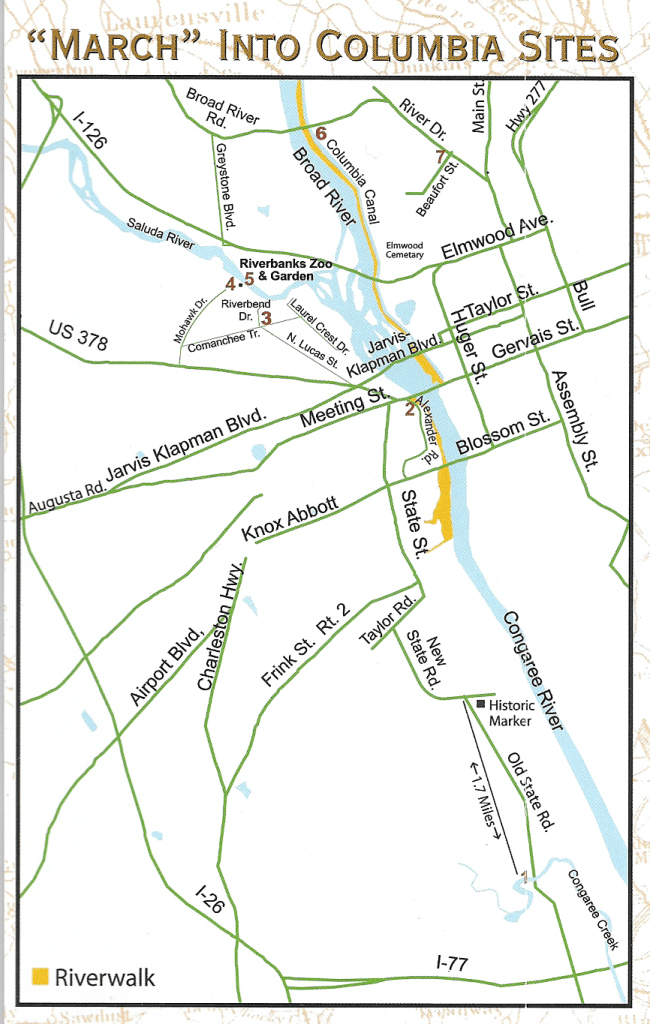Having successfully completed his march to the sea by capturing Savannah in December of 1864, Union Major General William Tecumseh Sherman planned his invasion of South Carolina. His target was Columbia, the state capital where the secession movement began and considered by Sherman’s generals to be a richer prize and more important capture than any city in the South. On January 30, 1865, Sherman’s 65,000-man army launched the invasion moving 10 to 12 miles a day, burning a swath 60 miles wide in grim determination readily viewed as retribution. An abundance of alcohol greeted the Union army as it entered Columbia on February 17, 1865. Vengeful attitude fueled by drunkenness culminated in the looting and burning of the city—an act described by a Union war correspondent as “the most monstrous barbarity of the barbarous march.”
Re-trace Sherman’s path into Columbia, stand where he stood, walk the same streets, see the preserved ruins and visit the structures spared a fiery death.
“The truth is, the whole army is burning with an insatiable desire to wreak vengeance upon South Carolina. I almost tremble at her fate, but feel that she deserves all that seems in store for her.” William Tecumseh Sherman
***Click here for printable tour guide and map***
- Congaree Creek In the early afternoon of February 15, 1865, Confederate troops under Gen. Matthew Butler advanced up State Road and fought Major Gen. John Logan’s XVth Corps at this site in the only major defense of Columbia. Confederate troops held their line of breastworks on the north side of the flooding creek but retreated when outflanked by Union troops. State Road was South Carolina’s first planned road from the coast to the mountains.
- Gervais Street Bridge At dawn on February 16, 1865, Union troops occupied the banks of the Congaree River opposite Columbia. Finding that the bridge had been burned by retreating Confederates, Union cannons began to shell the city. At about 9 a.m., Sherman arrived on this site and ordered the artillery battery of Capt. Francis DeGress to fire on the railway station and the granite State House under construction. Today, stars mark the exterior walls of the State House where the cannon balls struck.
- Camp Sorghum With the Gervais Street Bridge burned, Sherman sent his troops north to the only other bridge on the Broad River. Along the way the troops found the remains of Camp Sorghum, a prisoner of war camp where 1,300 to 1,400 Federal officers had been held without shelter in an open field. In December 1864 the remaining POWs were moved to the grounds of the “Lunatic Asylum” in Columbia (State Hospital). When Sherman’s XVth Corps passed by the site of Camp Sorghum, many soldiers were angered by the remaining evidence of the sufferings their fellow soldiers had endured.
- Saluda Mill (Columbia Mill) About noon on February 16, 1865, Sherman’s troops reached the Saluda Mill. The Saluda Manufacturing Company, chartered in 1834, was once one of the largest textile mills in the world and one of the oldest in South Carolina. The mill’s original investors built a four-story granite structure with a dam that covered the Saluda River. In 1855, Col. James G. Gibbs of Columbia bought the property and renamed the factory The Columbia Cotton Mill. Eighty looms and thousands of spindles were operated by up to 1,000 workers, mostly women and slaves, turning out goods for the war effort. Union troops burned the building and destroyed the dam after crossing the Saluda River. The ruins are protected by the Riverbanks Zoo and Gardens.
- Saluda River Bridge The Confederates had burned this covered bridge over the Saluda River to impede the Union troops advance to the Broad River Bridge. By mid afternoon on February 16, 1865, Gen. Logan’s XVth Corps had laid a pontoon bridge and crossed the river under the protection of Union sharp shooters on the top floor of the Saluda Mill. The remains of the granite bridge abutments and supporting pier foundations can be seen from the Riverbanks Zoo and Garden footbridge.
- Broad River Crossing Just as the Union troops reached the Broad River Bridge at this site, the Confederates fired the bridge, which had already been covered with rosin, tar and turpentine. The bridge burned so fast than not even all the retreating Confederate cavalry could cross. Union troops waited until dark to cross the flooded river in pouring rain. At about 3 a.m. on February 17, 1865, a brigade under the command of Colonel George Stone was ferried across the river and provided protection for the laying of a pontoon bridge.
- Columbia Surrendered At 10 a.m. on February 17, 1865, Columbia Mayor Goodwyn met Colonel Stone at this site to surrender the city. The Mayor received assurances that the city would be unharmed except for some public government buildings. Stone’s men then marched into the city of about 14,000 women, children and old men as Sherman and the rest of his occupying force crossed over the pontoon bridge and followed. That night all of the business and much of the residential area of the city was burned.
